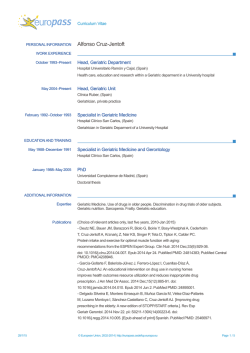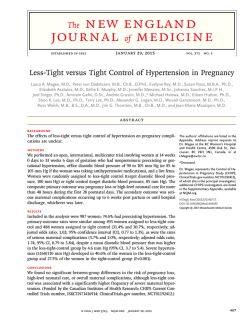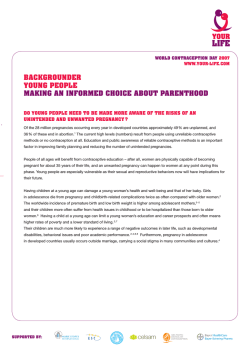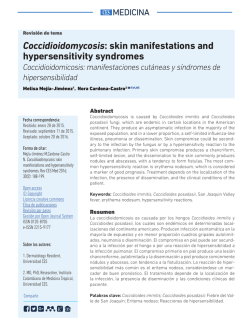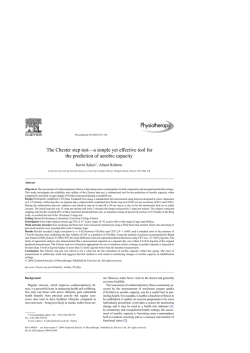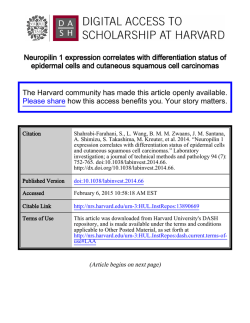
original article - journal of evolution of medical and dental sciences
DOI: 10.14260/jemds/2015/212 ORIGINAL ARTICLE EFFECT OF A EXERCISE BY PREGNANT WOMEN AND BIRTH WEIGHT: A RANDOMIZED CONTROLLED TRIAL Nayana Prabhu1 HOW TO CITE THIS ARTICLE: Nayana Prabhu. “Effect of a Exercise by Pregnant Women and Birth Weight: A Randomized Controlled Trial”. Journal of Evolution of Medical and Dental Sciences 2015; Vol. 4, Issue 09, January 29; Page: 1508-1515, DOI: 10.14260/jemds/2015/212 ABSTRACT: BACKGROUND: To date there are contradictory results regarding the role of physical activity on birth weight. In addition, it is questioned whether exercise during second and third trimesters of pregnancy might affect gestational age and increase the risk of preterm delivery. Hence, the purpose of this study was to examine the effect of a supervised exercise-program on birth weight, gestational age at delivery and Apgar-score.METHODS: Sedentary, nulliparous pregnant women (N = 105), mean age 30.7 ± 5.0 years, pre-pregnancy BMI 23.8 ± 5.3 were randomized to either an exercise group (EG, n = 52) or a control group (CG, n = 53). The exercise program consisted of supervised aerobic dance and strength training for 45 minutes, thrice per week for a minimum of 12 weeks, with an additional 30 minutes of self-imposed physical activity on the non-supervised weekdays.RESULTS: There was no statistically significant difference between groups in mean birth weight, low birth weight (< 2500 g) or macrosomia (≥ 4000 g). Per protocol analyses showed higher Apgar score (1 min) in the EG compared with the CG (p = 0.02). No difference was seen in length of gestation.CONCLUSION: Aerobic, yoga exercise was not associated with reduction in birth weight, preterm birth rate or neonatal well-being. KEYWORDS:Exercise, Birth weight, rish. INTRODUCTION: BACKGROUND: pregnant women are encouraged to be physically active for at least 30 minutes on most days of the week, in the absence of medical or obstetrical contraindications.[1,2,3] Wolfe and Davies[3] recommended that previous sedentary women should start moderate exercise for a minimum of 15 minutes, 3 to 4 times a week and increase to 30 minutes 5 times a week. However, the optimal dose for recreational physical activity during pregnancy remains to be determined, and the impact of prolonged and repeated aerobic exercise on clinical outcomes for mother and infant are still unknown.[4,5] A systematic review associated physically demanding work with increased risk of premature birth,[6]whereas a recent large cohort study showed increased risk of early spontaneous abortion[7] with > 7 h/wk of high impact exercise.[8] Potential risk factors of exercise have been listed as fetal hyperthermia with potential teratogenic effects, reduction of oxygenated blood flow (leading to fetal hypoxia) and reduction in essential substrates leading to fetal growth restriction.[3] Birth weight plays an important role in infant mortality and morbidity, childhood development, and adult health.[9-10] Low birth weight babies are at an increased risk for mortality, short term and long term morbidities.[11,12] Another concern is the increasing prevalence of newborns with high birth weight[13] or fetal macrosomia.[14,15] Several studies show that birth weight ≥ 4000 g is associated with acute complications such as prolonged labour, shoulder dystocia, operative delivery and lacerations.[16-17] Long term health risks include diabetes, obesity, metabolic syndrome and some types of cancer.[18-19] J of Evolution of Med and Dent Sci/ eISSN- 2278-4802, pISSN- 2278-4748/ Vol.4/ Issue 09/Jan 29, 2015 Page 1508 DOI: 10.14260/jemds/2015/212 ORIGINAL ARTICLE Previous studies investigating the effect of exercise during pregnancy and birth weight report inconsistent findings [20]. A Cochrane review from 2009, found no effects of maternal exercise on birth weightand concluded that few studies have examined exercise as a determinant of birth weight. The purpose of the present study was to examine the effect of aerobic dance exercise [21] thrice a week, in addition to 30 minutes of moderate self-imposed physical activity on the remaining weekdays, on birth weight[22], including the proportion of small (< 2500 g) and large (≥ 4000 g) newborns in nulliparous previously inactive pregnant women. The research hypothesis of the present study was: METHODS: Participants: Nulliparous women whose pre-pregnancy exercise levels did not include participation in a structured exercise program (> 45 minutes once per week), including brisk walking [23] (> 120 minutes per week) for the past six months, were eligible for the trial. Exclusion criteria were a history of more than two miscarriages, severe heart disease (Including symptoms of angina, myocardial infarction or arrhythmias), persistent bleeding after 12 weeks of gestation, multiple pregnancy, poorly controlled thyroid disease, pregnancy-induced hypertension or pre-eclampsia, diabetes or gestational diabetes, and other diseases that could interfere with participation. In addition, women not able to attend weekly exercise classes were ineligible[24]. Participants were recruited via articles and advertisement in newspapers, health practitioners (physicians, midwives) and websites for pregnant women. In total, the participants were examined three times during the study period. The first visit was between 12 and 24 weeks of gestation (Baseline visit), the second at week 36-38 (After the intervention) and the last 6-12 weeks after delivery (Postpartum visit). Each visit lasted approximately 60-75 minutes. Some women who were lost to the second visit and test after the intervention[25] (Lost to follow up), re-entered the study at the postpartum examination. There was no financial compensation to the participants. Randomization: A simple randomization procedure was used, and no stratification was done. The principal investigator (LAHH) was not involved in training the women and was blinded to group allocation while assessing the outcome measures, plotting and analyzing the data. Intervention: Participants randomized to EG were encouraged to participate in at least two out of three possible one hour aerobic dance classes per week, for a minimum of 12 weeks. Each session started with 5 minutes warm up, followed by 25 minutes of aerobic dance[26], including cool down. This was followed by 10minutes of strength training with a special focus on the deep abdominal stabilization muscles (internal oblique and the transverse abdominal muscle), pelvic floor and back muscles. The last 5 minutes included stretching, relaxation and body awareness exercises.. The exercise-program followed the ACOG exercise prescription.[1,27]The exercise program was choreographed and led by certified aerobic-instructors, and each session included a maximum of 20 participants. In addition to joining the scheduled aerobic classes, all women in the EG were asked to include 30 minutes of moderate self-imposed physical activity[28] on the remaining week-days. They were also advised to incorporate short bouts of activity into their daily schedules. Adherence to the J of Evolution of Med and Dent Sci/ eISSN- 2278-4802, pISSN- 2278-4748/ Vol.4/ Issue 09/Jan 29, 2015 Page 1509 DOI: 10.14260/jemds/2015/212 ORIGINAL ARTICLE exercise classes was controlled by the aerobic-instructors, and the self-imposed daily activity was registered in a personal training diary. It was not considered unethical to use a control group not receiving treatment in the present study. However, control participants were neither encouraged to, nor discouraged from, exercising, as we considered asking the CG not to exercise to be against current guidelines. In order to treat the two groups identically apart from the experimental intervention, the CG underwent all tests and completed the same interview as the EG. Outcome Measure: The baseline interview covered demographic information (e.g. age, pregnancy week, smoking habits, education, occupation), assessment of daily life physical activity and sedentary behaviour (At work, transportation and household). The questionnaire has been validated with a portable activity monitor. At the postpartum test, birth weight, length, head circumference, gestational age at time of delivery and Apgar score at 1 and 5 min after birth were registered from labor and delivery records. The main outcome measure was infant birth weight measured in grams. In addition, newborns birth weight was grouped according to low birth weight (LBW) (< 2, 500 g), normal birth weight (2, 500-3, 999 g) and macrosomia (≥ 4, 000 g) . Secondary outcome measures were gestational age at delivery and Apgar score. Newborn characteristics were obtained from labor and delivery records and interviews with the participants. Statistical Analysis: The principal analysis was done on an intention to treat basis (ITT). Because, drop-outs rates in the present study were less than 20%, missing values were replaced with the mean value in the EG and CG, respectively. In addition, we performed per protocol analysis based on adherence to ≥ 80% of the recommended exercise sessions (≥ 19 exercise sessions) and compared women with 100% exercise adherence (24 exercise sessions) with the CG. Average infant birth weight was compared between the two groups and the possible difference was tested using a twosided independent sample t-test. The group differences in proportion of newborns with low birth weight (LBW) (< 2500 g) and macrosomia (≥ 4000 g) were tested by using two-sided X2-test. Level of statistical significance was set to p < 0.05. RESULTS: In total, 85.7% of the participants met at the postpartum visit where measurements of birth weight was obtained, at mean 7.7 (SD 1.7) weeks postpartum. One woman in the EG and one in the CG were excluded due to twin birth and poorly controlled thyroid disease after the first assessment, respectively. Three drop-outs were due to complications with the baby, five due to relocations and withdrawals, and five were unknown reasons. There was no difference in maternal physical characteristics between the women who completed the study and those lost to follow-up. Adherence to the EG was mean 17.0 (SD 12.5) sessions and 21 (40.4%) attended ≥ 80% of the exercise sessions. After the intervention period, six of 53 women in the CG reported that they had exercised ≥ 2 times per week for 45 minutes of moderate intensity. None of the exercises performed by the CG were supervised, as opposed to the EG. Birth Weight: mean newborn birth weight in the EG and CG of the ITT, per protocol analysis and analyzes of women attending 24 exercise sessions. Excluding the women who reported to exercising regularly in the CG (n = 6) did not change the overall results. J of Evolution of Med and Dent Sci/ eISSN- 2278-4802, pISSN- 2278-4748/ Vol.4/ Issue 09/Jan 29, 2015 Page 1510 DOI: 10.14260/jemds/2015/212 ORIGINAL ARTICLE Newborn birth weight and offspring characteristics in the exercise and control groups (mean (SD) and N (%)), analyzed by intention to treat (ITT), per protocol (≥ 80% of exercise sessions) and analyses of 100% exercise adherence (24 exercise sessions) We did not find statistically significant differences between the two groups in mean birth weight, length, head circumference, and length of gestation, according to ITT-analysis. Per protocol analysis showed a statistical significant difference between the two groups in Apgar score (1 min), with newborns of the EG scoring higher than the CG. No newborn in the EG had a score < 7, compared with two newborns in the CG. The prevalence of newborns with low birth weight (LBW) (< 2500 g) was 1.9% in both groups. Macrosomia (≥ 4000 g) was 9.6% (5 of 52) and 17% (9 of 53), in the EG and CG, respectively (p = 0.5). No major adverse effects or health problems resulting from the exercise program were reported. Two preterm deliveries occurred in the EG (gestational age: 36.1 and 36.5) and one preterm delivery in the CG (gestational age: 35.0). There were no reports of miscarriage in either group during this study. DISCUSSION: This is one of very few RCTs investigating the effect of a supervised structured exercise program on birth weight. No negative effects of a thrice a week 12 week aerobic dance program in 2nd and 3rd trimester of pregnancy in previously sedentary women were found, and there was no statistically significant difference between groups in mean birth weight, low birth weight (< 2500 g) or macrosomia (≥ 4000 g). Regular exercise during pregnancy did not affect gestational age or prematurity. The strengths of the present study were use of an assessor blinded RCT design, few losses to follow-up and implementation of an exercise program following ACOG recommendations, conducted by certified personnel in a supervised setting. In addition, we aimed at integration of exercises into daily life activities, a focus not reported in other studies.Adherence to the training protocol was registered, and all follow-up procedures were done by the same investigator. A limitation was the adherence to the training program, and that variation in nutritional intake was not assessed. However, EG and CG had similar gestational weight gain. Sample size determination for birth weight was not based on a-priory power calculations. Post priori power calculations showed that we would need 64 subjects in each group to detect a mean difference in newborn birth weight between EG and CG of 230 g (6-7% difference in birth weight), significant at the 5% level with a power of 80%. In addition, post priori calculation of difference in newborns with macrosomia (same alpha and power), showed that 262 participants were needed in each group, respectively. The results of the present study are difficult to compare with other studies since the prescribed exercise dosages vary widely, in addition to inclusion of different study populations, time in pregnancy and the length of the intervention. Clapp[29] reported that previously physically inactive women who were assigned at gestation week 8 to exercise for 20 minutes 3-5 times per week for the remainder of pregnancy, gave birth to significantly heavier newborns than the control women (3750 g vs. 3490 g, p = 0.05). Hopkins et al reported opposite results and concluded that regular exercise (Five sessions of 40 min stationary cycling per week) was associated with lower birth weight (3426 g vs. 3569 g). A recent Cochrane review, involving 258 women and their newborns, concluded that the J of Evolution of Med and Dent Sci/ eISSN- 2278-4802, pISSN- 2278-4748/ Vol.4/ Issue 09/Jan 29, 2015 Page 1511 DOI: 10.14260/jemds/2015/212 ORIGINAL ARTICLE available data were insufficient to infer important risks or benefits of maternal exercise on birth weight. A meta-analysis based on both experimental, quasi-experimental and cohort studies, concluded that exercise in pregnancy generally does not affect birth weight. Our results support this conclusion. In the present study, we did not find a significant difference in mean birth weight between EG and CG, nor number of LBW babies. However, we observed that the prevalence of newborns with birth weight ≥ 4000 g was 9.6% (n = 5) in the EG vs. 17% (n = 9) in the CG. This is consistent with findings of Barakat et al,[20]showing higher prevalence of macrosomic babies in the control group than in the training group (1.4% vs.10%). In Finland, Kinnunen et al,found a 15% incidence of newborns above 4000 g in the control group, whereas there was no newborns exceeding 4000 g in the intervention group. Macrosomic infants have an increased risk of developing diabetes, obesity and metabolic syndrome.. Hence, this gives support to start prevention interventions in pregnancy. Another interesting finding in the present study was that mean Apgar score of the newborns was higher in the EG compared to the CG at 1-minute. However, by 5-minutes there was no difference. Clinically, the 5-minute score may be more relevant, as this score assesses how well the newborn is adapting to the new environment, compared to how well the baby has tolerated the birthing process (1-minute score). Nevertheless, the results of the present study confirm previous data which showed that moderate intensity aerobic exercise does not negatively affect birth outcomes or gestational age.[20] The moderate intensity of the exercise classes in the present study, followed the ACOG guidelines[1] and can easily be achieved in most aerobic classes or by brisk walking. However, the present study also demonstrated that it is difficult to motivate former sedentary women to fulfil the ACOG exercise recommendations. A main limitation of the present study is related to the difficulties the participants in the EG had in regularly attending the scheduled aerobics dance sessions. On the other hand, this may represent a realistic picture of the possibilities of recruiting sedentary pregnant women, even in those with low-risk pregnancies. In a recent RCT, the most frequently reported barriers for low adherence to exercise groups were children and household duties, job-imposed limitations, lack of transportation and distance between the woman's home and the fitness club. Few of these factors were present in our study, and why the nulliparous women in the present study did not adhere is difficult to understand. A fitness class of 45 minutes prescribed thrice a week, including endurance training of 30 minutes may be considered demanding. Thus, the sedentary women being the target group for this study may have been less motivated to adhere to this specific program. In addition, time management is vital if an exercise program is to be successful. RCT's are time consuming and involve cooperation from the participants. Hence, pregnant women who volunteer for such a study may have an interest and be more attentive to these aspects than non-participants, creating a potential risk for selection bias. The pregnant women in this study were healthy nulliparous with a high educational level, and are therefore not representative for all eligible women. CONCLUSION: Aerobic-dance exercise for sedentary pregnant women appeared to be safe and was not associated with any reduction in newborn birth weight, preterm birth rate or neonatal wellbeing. Further studies on strategies to achieve adherence to exercise protocols among previous sedentary pregnant women are warranted. J of Evolution of Med and Dent Sci/ eISSN- 2278-4802, pISSN- 2278-4748/ Vol.4/ Issue 09/Jan 29, 2015 Page 1512 DOI: 10.14260/jemds/2015/212 ORIGINAL ARTICLE REFERENCES: 1. Olson D, Sikka RS, Hayman J, Novak M, Stavig C: Exercise in pregnancy.Curr Sports Med Rep 2009, 8(3):147-53. PubMed Abstract Publisher Full Text OpenURL. 2. Kramer MS, McDonald SW: Aerobic exercise for women during pregnancy.Cochrane Database Syst Rev 2006, 3:CD000180. PubMed Abstract Publisher Full Text OpenURL. 3. Chasan-Taber L, Evenson KR, Sternfeld B, Kengeri S: Assessment of recreational physical activity during pregnancy in epidemiologic studies of birthweight and length of gestation: methodologic aspects.Women Health 2007, 45(4):85-107. PubMed Abstract Publisher Full Text OpenURL. 4. Bonzini M, Coggon D, Palmer KT: Risk of prematurity, low birthweight and pre-eclampsia in relation to working hours and physical activities: a systematic review.Occup Environ Med 2007, 64(4):228-43. PubMed Abstract Publisher Full Text PubMed Central Full Text OpenURL. 5. Madsen M, Jorgensen T, Jensen ML, Juhl M, Olsen J, Andersen PK, Nybo Andersen AM: Leisure time physical exercise during pregnancy and the risk of miscarriage: a study within the Danish National Birth Cohort.BJOG 2007, 114(11):1419-26. PubMed Abstract | Publisher Full Text | PubMed Central Full Text OpenURL. 6. Frankel S, Elwood P, Sweetnam P, Yarnell J, Smith GD: Birthweight, body-mass index in middle age, and incident coronary heart disease.Lancet 1996, 348:1478-80. PubMed Abstract | Publisher Full Text OpenURL. 7. Clayton PE, Cianfarani S, Czernichow P, Johannsson G, Rapaport R, Rogol A: Management of the child born small for gestational age through to adulthood: a consensus statement of the International Societies of Pediatric Endocrinology and the Growth Hormone Research Society.J ClinEndocrinolMetab 2007, 92(3):804-10. PubMed Abstract Publisher Full Text OpenURL. 8. Osler M, Lund R, Kriegbaum M, Andersen AM: The influence of birth weight and body mass in early adulthood on early coronary heart disease risk among Danish men born in 1953.Eur J Epidemiol 2009, 24(1):57-61. PubMed Abstract Publisher Full Text OpenURL. 9. Barker DJ, Eriksson JG, Forsen T, Osmond C: Fetal origins of adult disease: strength of effects and biological basis.Int J Epidemiol 2002, 31(6):1235-9. PubMed Abstract Publisher Full Text OpenURL. 10. Heiskanen N, Raatikainen K, Heinonen S: Fetal macrosomia--a continuing obstetric challenge.Biol Neonate 2006, 90(2):98-103. PubMed Abstract Publisher Full Text OpenURL. 11. Zhang X, Decker A, Platt RW, Kramer MS: How big is too big? The perinatal consequences of fetal macrosomia.Am J ObstetGynecol 2008, 198(5):517-6. PubMed Abstract Publisher Full Text OpenURL. 12. Egeland GM, Skjaerven R, Irgens LM: Birth characteristics of women who develop gestational diabetes: population based study.BMJ 2000, 321:546-7. PubMed Abstract Publisher Full Text PubMed Central Full Text OpenURL. 13. Boulet SL, Alexander GR, Salihu HM, Pass M: Macrosomic births in the united states: determinants, outcomes, and proposed grades of risk.Am J ObstetGynecol 2003, 188(5):1372-8. PubMed Abstract Publisher Full Text OpenURL. 14. Kajantie E, Osmond C, Barker DJ, Forsen T, Phillips DI, Eriksson JG: Size at birth as a predictor of mortality in adulthood: a follow-up of 350 000 person-years.Int J Epidemiol 2005, 34(3):65563. PubMed Abstract Publisher Full Text OpenURL. J of Evolution of Med and Dent Sci/ eISSN- 2278-4802, pISSN- 2278-4748/ Vol.4/ Issue 09/Jan 29, 2015 Page 1513 DOI: 10.14260/jemds/2015/212 ORIGINAL ARTICLE 15. McCormack VA, dos SS, Koupil I, Leon DA, Lithell HO: Birth characteristics and adult cancer incidence: Swedish cohort of over 11, 000 men and women.Int J Cancer 2005, 115(4):611-7. PubMed Abstract Publisher Full Text OpenURL. 16. Barakat R, Lucia A, Ruiz JR: Resistance exercise training during pregnancy and newborn's birth size: a randomised controlled trial.Int J Obes 2009, 33(9):1048-57. Publisher Full Text OpenURL. 17. Collings CA, Curet LB, Mullin JP: Maternal and fetal responses to a maternal aerobic exercise program.Am J ObstetGynecol 1983, 145(6):702-7. PubMed Abstract OpenURL. 18. Hopkins SA, Baldi JC, Cutfield WS, McCowan L, Hofman PL: Exercise training in pregnancy reduces offspring size without changes in maternal insulin sensitivity.J ClinEndocrinolMetab 2010, 95(5):2080-8. PubMed Abstract Publisher Full Text OpenURL. 19. Artal R, O'Toole M: Guidelines of the American College of Obstetricians and Gynecologists for exercise during pregnancy and the postpartum period.Br J Sports Med 2003, 37(1):6-12. PubMed Abstract Publisher Full Text PubMed Central Full Text OpenURL. 20. Borg G: Perceived exertion as an indicator of somatic stress.Scand J Rehabil Med 1970, 2(2):928. PubMed Abstract OpenURL. 21. Bell R, Palma S: Antenatal exercise and birthweight.Aust N Z J ObstetGynaecol 2000, 40(1):70-3. PubMed Abstract Publisher Full Text OpenURL. 22. Kramer MS, McDonald SW: Aerobic exercise for women during pregnancy.Cochrane Database Syst Rev 2009, 3(1):CD000180. OpenURL. 23. Haakstad LA, Gundersen I, Bo K: Self-reporting compared to motion monitor in the measurement of physical activity during pregnancy.ActaObstetGynecolScand 2010, 89(6):74956. PubMed abstract Publisher Full Text OpenURL. 24. Scifres CM, Stamilio D, Allsworth J, Shanks A, Lewkowski B, Shroff R: Perinatal consequences of fetal macrosomia: Zhang et al.Am J ObstetGynecol 2008, 198(5):603-4. PubMed abstract Publisher Full Text OpenURL. 25. Armijo-Olivo S, Warren S, Magee D: Intention to treat analysis, compliance, drop-outs and how to deal with missing data in clinical research:a review.Physical Therapy Reviews 2009, 14(1):36-49. Publisher Full Text OpenURL. 26. Wright CC, Sim J: Intention-to-treat approach to data from randomized controlled trials: a sensitivity analysis.J ClinEpidemiol 2003, 56(9):833-42. PubMed Abstract | Publisher Full Text OpenURL. 27. Wolfe LA, Davies GA: Canadian guidelines for exercise in pregnancy.ClinObstetGynecol 2003, 46(2):488-95. PubMed Abstract Publisher Full Text OpenURL. 28. Haakstad LA, Bo K: Effect of regular exercise on prevention of excessive weight gain in pregnancy: A randomised controlled trial.Eur J ContraceptReprod Health Care 2011, 16(2):11625. PubMed Abstract | Publisher Full Text OpenURL. 29. Henriksen T: The macrosomic fetus: a challenge in current obstetrics.ActaObstetGynecolScand 2008, 87(2):134-45. PubMed Abstract Publisher Full Text OpenURL. J of Evolution of Med and Dent Sci/ eISSN- 2278-4802, pISSN- 2278-4748/ Vol.4/ Issue 09/Jan 29, 2015 Page 1514 DOI: 10.14260/jemds/2015/212 ORIGINAL ARTICLE AUTHORS: 1. Nayana Prabhu PARTICULARS OF CONTRIBUTORS: 1. Associate Professor, Department of Obstetrics and Gynaecology, Srinivas Medical College, Mukka, Mangalore. NAME ADDRESS EMAIL ID OF THE CORRESPONDING AUTHOR: Dr. Nayana Prabhu, Associate Professor, Department of Obstetrics and Gynaecology, Srinivas Medical College, Mangalore. E-mail: [email protected] Date of Submission: 27/12/2014. Date of Peer Review: 29/12/2014. Date of Acceptance: 19/01/2015. Date of Publishing: 28/01/2015. J of Evolution of Med and Dent Sci/ eISSN- 2278-4802, pISSN- 2278-4748/ Vol.4/ Issue 09/Jan 29, 2015 Page 1515
© Copyright 2025
